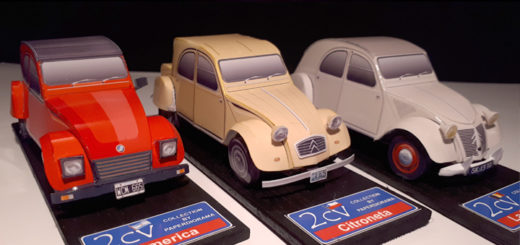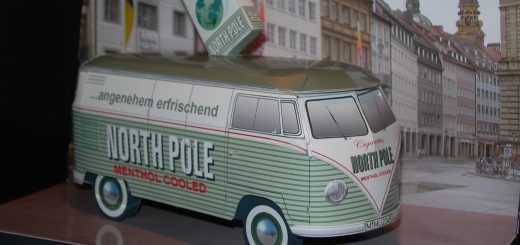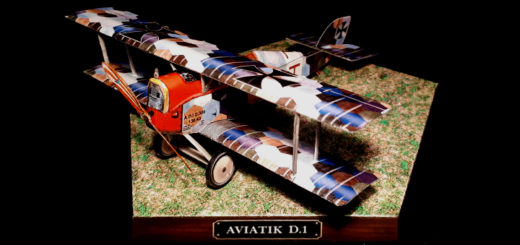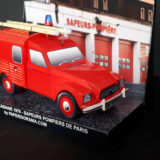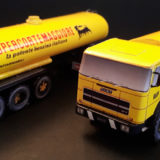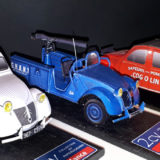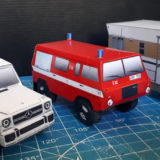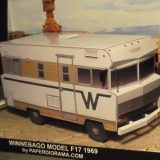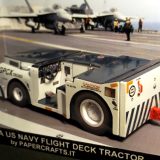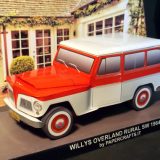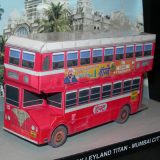2 CV COLLECTION VOL.5/N.1 : AMBULANCE – Paper model 1/35 scale
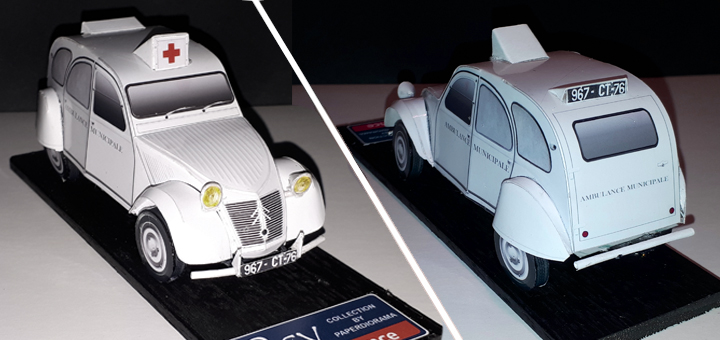
Few data exist regarding this 2 cv transformed into an ambulance by the Le Bastard body shop in Rouen in 1953.The main elements of the elaboration consisted in the replacement of the canvas roof with a metal one, with consequent and inevitable weight increase of the bodywork, furthermore it was foreseen the removal of the seats to make room for the litter with the patient.The development did not have a commercial follow-up because, due to the weight increase, the performance on the road was completely inadequate.
Download 2 CV COLLECTION VOL.5/N.1 : AMBULANCE – Paper model 1/35 scale
2 CV COLLECTION VOL.5/N.2 : SAPEURS POMPIERS – Paper model 1/35 scale
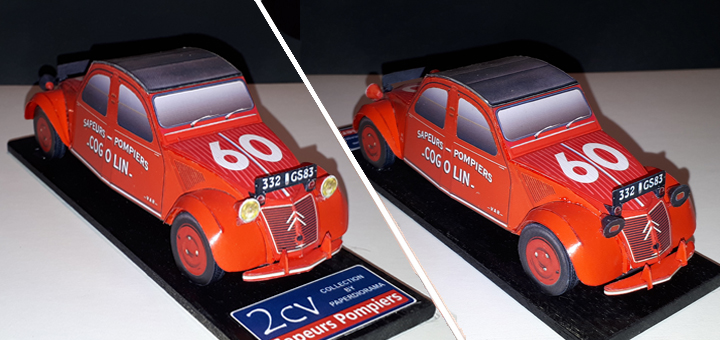
The genesis – In the 1950s the departmental inspector of the Var, Colonel ourcastagné, conducts a night reconnaissance on a mountain road with his 15 HP Front Wheel Drive. Blocked and unable to turn around, he had to turn back in the light of an electric torch, guided by his driver! Following this unpleasant, and dangerous, situation a reflection is conducted between the fire department and foresters on the design of a econnaissance vehicle suitable for roads and steep slopes of the department.The realization – The General Council allocates a budget and two Citroën 2CVs are acquired and transferred to Neuilly-sur-Seine. Both frames are sawn, the front parts clear and assembled back to back. The result is a “two-headed” chassis consisting of two engines, two transmissions, two directions, two steering wheels …If the two parts are welded they nevertheless retain their independence. When the vehicle is traveling in one direction, the opposite direction is neutralized by a locking bar. In evolution 4×4 a motor is driven forward while the gearbox of the other is engaged in reverse. The ground clearance is not changed and it will pose a lot of difficulties at some crossings because of the long wheelbase of the machine (almost 3 meters!). The suspension is however reinforced.In service – This double 2CV was assigned in 1956 to the emergency center of Cogolin after several months of use to the direction of the fire services in Draguignan. It will be alongside Jeeps and GMC military surpluses frequently used at that time by firefighters facing forest fires. It is engaged in reconnaissance but will be mainly used as a mobile command post and radio vehicle. As a result, it will be engaged in a large part of the department and its reputation will grow, amplified by the many French and foreign tourists who will cross it on their way.She was removed from service in 1971, replaced by a Jeep and entrusted to the administration of Domains.Much later, aware of the historical interest of this unique machine in the annals of the firefighters of the Var and France, the firefighters of the Var command the realization of a replica at the Lycée des Métiers Georges Cisson in Toulon.(Text by Olivier Gabriel) Note for diecast collector – there is a nice 1/43 scale double 2cv reproduction by Norev.
Download 2CV COLLECTION VOL.5/N.2 : SAPEURS POMPIERS – Paper model 1/35 scale
2 CV COLLECTION VOL.5/N.3 : 2CV G.H.A.N.1 – Paper model 1/35 scale
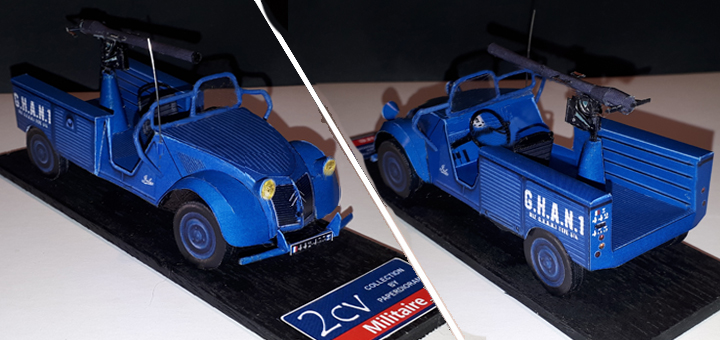
On 26th September 1959, command of the GHAN 1 (Naval Aviation Helicopter Group) was granted to a Capitaine de Corvette (corvette captain, the equivalent rank generally being lieutenant commander) Eugène Babot, a Free French Navy and Indochina veteran. Babot appears to have been the one to decide to arm three helicopters of the GHAN 1 with MG 151/20 20 mm autocannons. He also initiated the search for a light-armed vehicle that could be air-transported by the HSS-1 helicopters of the GHAN. Babot was quick to consider the ubiquitous French car of the era, the Citroën 2CV, a small, rustic car in production since 1948 which had been designed for rural use. He imagined that, stripped of most of its body, the 2CV would provide a very light platform that could potentially be fitted with some form of weaponry. The particular type of 2CV which was used appears to be a 2CV AZU, a utility vehicle that replaced the rear seats for storage space. This vehicle type was very widely used by French shopkeepers. The engine used on the vehicle in the late 1950s and early 1960s production was a boxer-two cylinder 425 cm3 gasoline engine producing 12 hp. At 530 kg, a 2CV AZU was a particularly light vehicle. It was 3.6 m long, 1.48 m wide, and 1.7 m tall.The modified 2CV was nicknamed ‘Jules’, Captain Babot’s radio code. The vehicle was given a registration number of “442 433”, painted on the rear left of the vehicle’s side and present on the frontal registration plate. On top of this registration number, a French flag and an anchor, a commonly used symbol of the DBFM, were drawn. The vehicle was painted in a sea blue color. On the rear sides, “GHAN 1” was inscribed in white, as well as an inscription that appears to read “Vle GHAN1 type G1A.”. The Vle likely was an abbreviation for véhicule (Eng: vehicle), with the inscription being a designation given to the vehicle, despite its ad hoc nature.The first option available to the vehicle consisted of recoilless rifles. It is mentioned that the vehicle was tested with two different recoilless rifles, a 57 mm one (the American M18) and a 75 mm one (the American M20). All known photos of the vehicle armed with a recoilless rifle appear to show it with the larger M20.The automatic weapon on the 2CV was the German MG151/20 20 mm autocannon. This German aviation gun was widely used in a variety of roles in post-war France. Inside helicopters, like those used by GHAN1, the autocannon was first used with a 60-80 round belt, and later, because of more advanced mounts, a much larger 500-rounds belt. Inside the 2CV GHAN1 vehicle, the shorter belts appear to have been more likely to be used due to the more limited space.Unlike the M20, however, the MG151 was not at all a recoilless weapon. From the existing photographs, it appears that firing over the sides would make the vehicle quite unstable and even lifted the rear wheel of the direction the gun was firing towards in the air by some extent. Still, the firepower provided by such a gun being mounted on a vehicle as light as the 2CV was once again very considerable.Captain Babot was relieved from command of the GHAN1 on 17th July 1961. Seemingly, around the same time, the trail of the armed 2CV goes cold.What eventually happened to the vehicle is entirely unknown. It may have had its armament removed and used as a pickup truck, lost due to an accident or breakdown, or abandoned in Algeria. Though one cannot exclude the possibility it was shipped back to France during the French Army’s retreat from Algeria in 1962, this would likely have been known and captured on camera. There is no evidence of that ever happening.(all notes extract from https://tanks-encyclopedia.com/2cv-ghan1/)
Download 2 CV COLLECTION VOL.5/N.3 : 2CV G.H.A.N.1 – Paper model 1/35 scale

